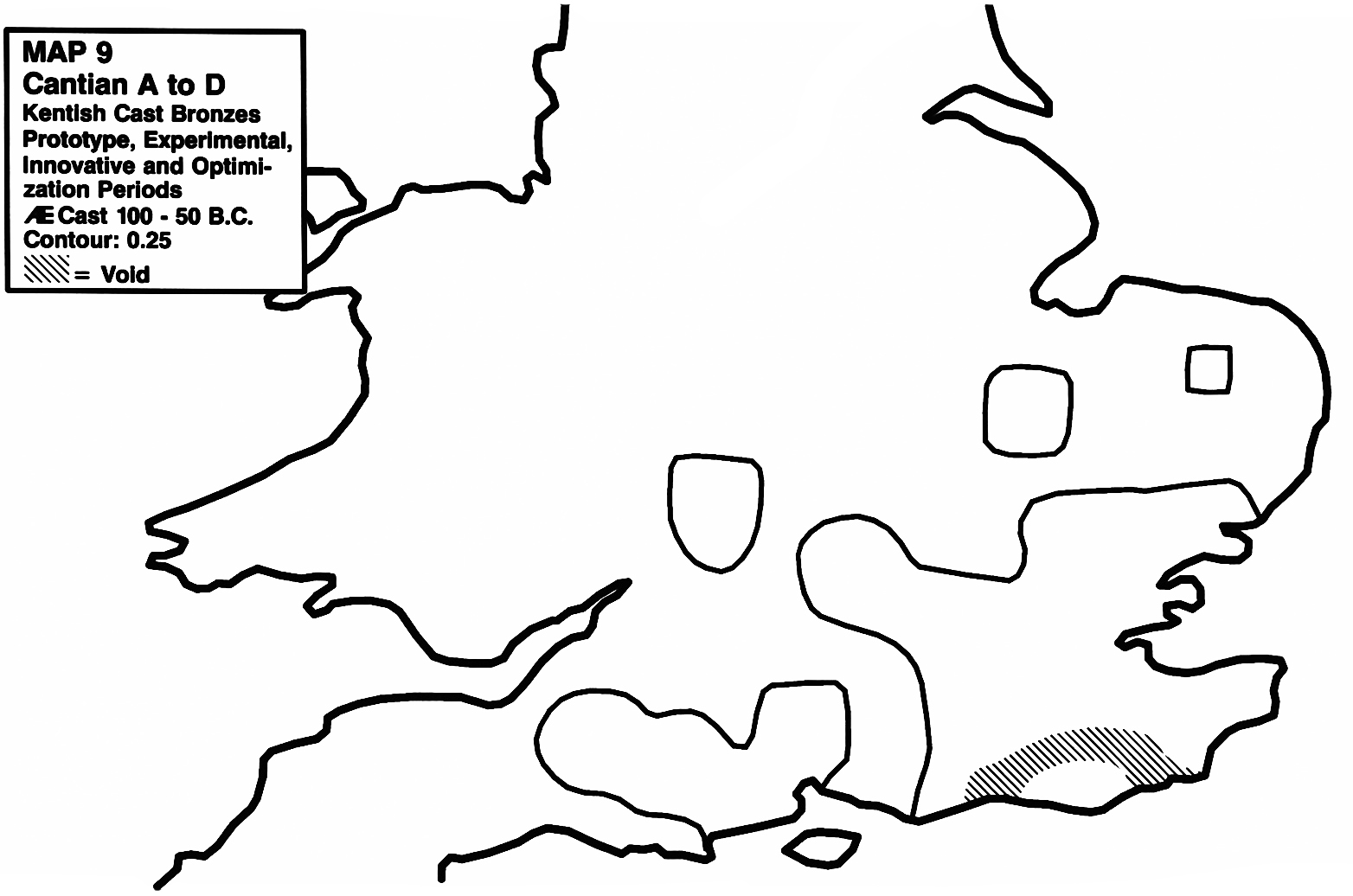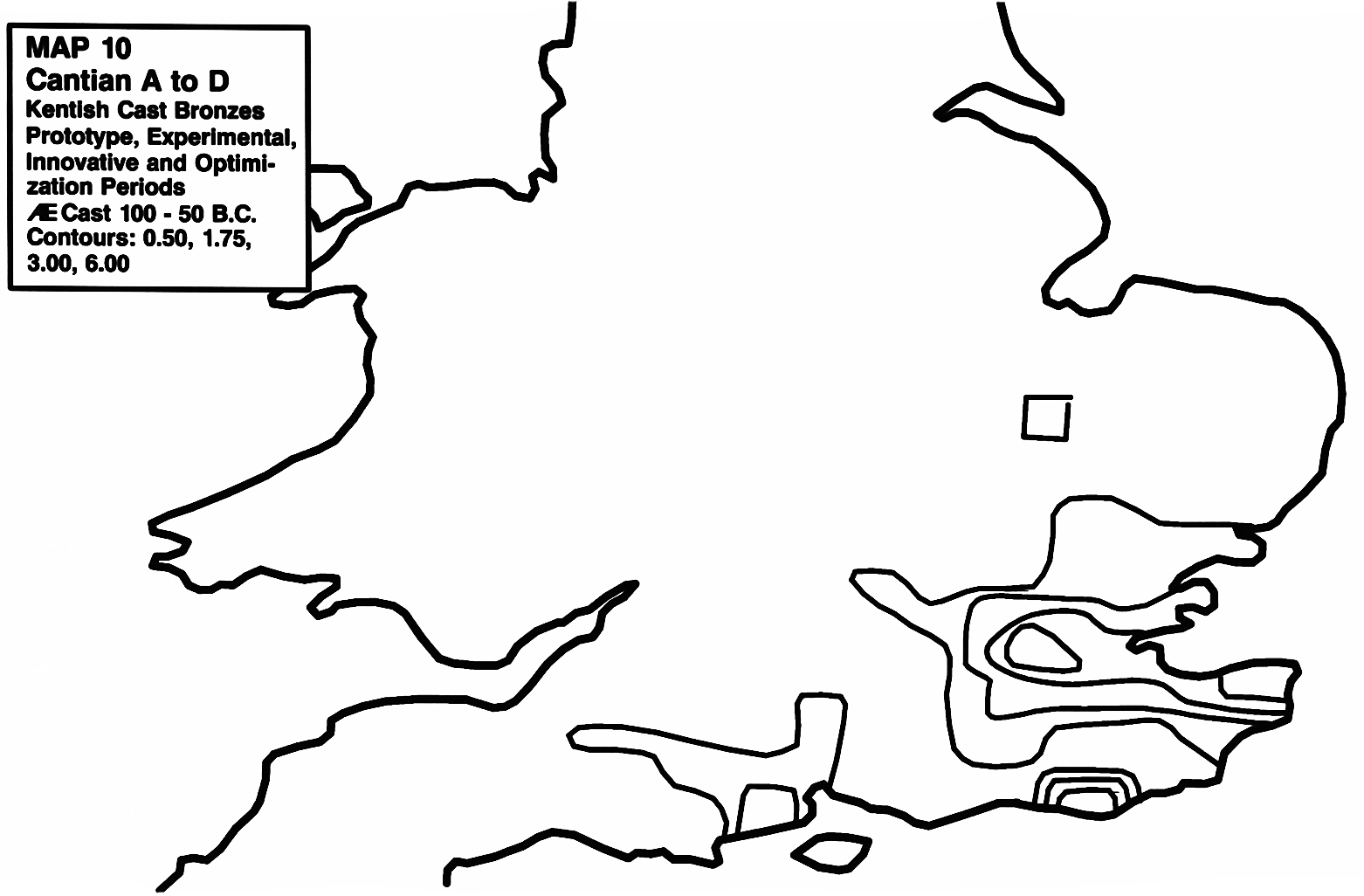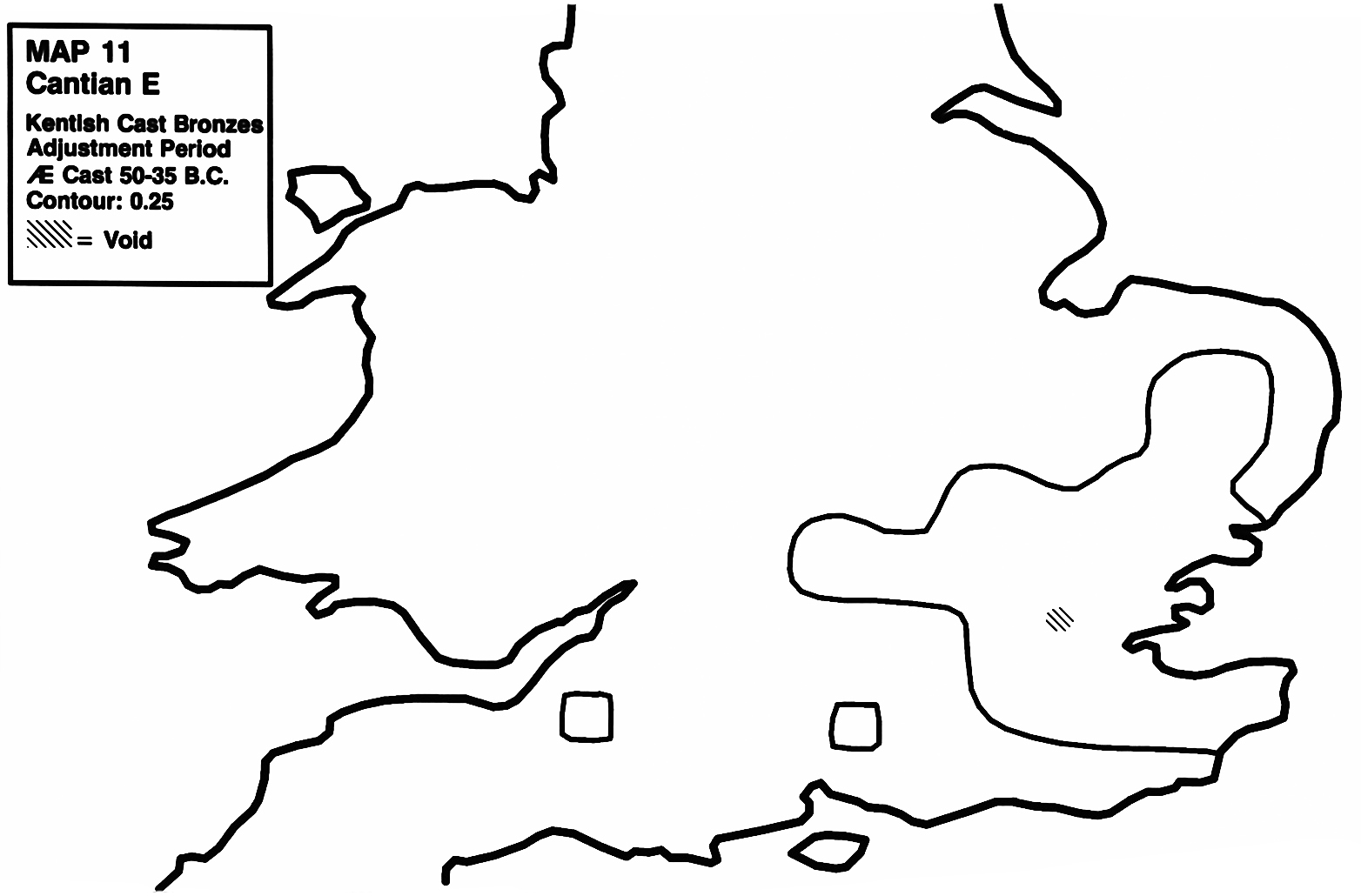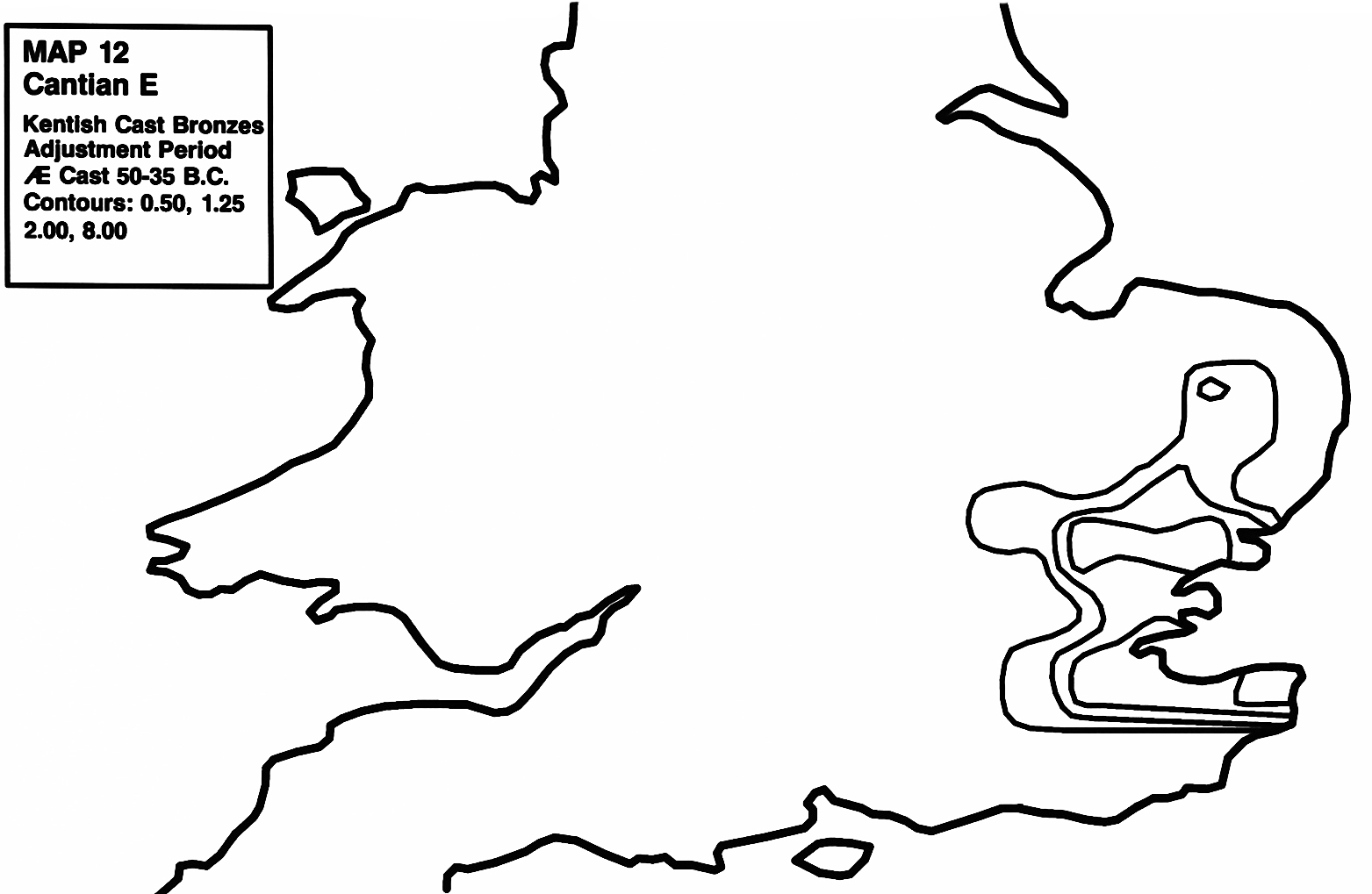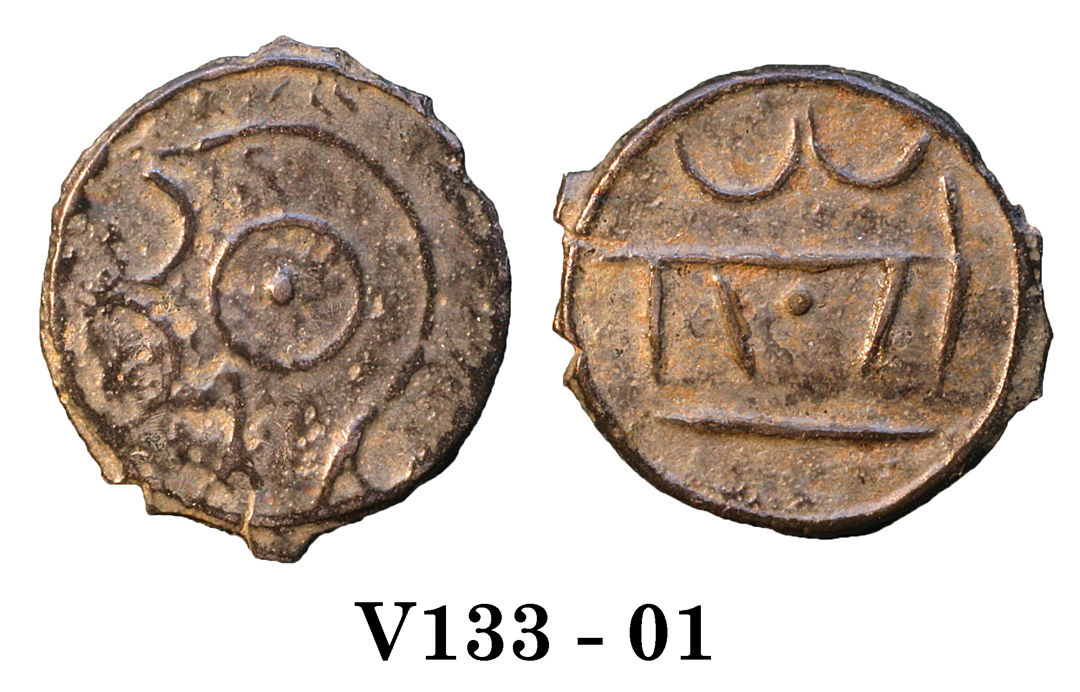
Numismatic Articles
Van Arsdell 2015c (Info)
Could Kent Kings Cast Coins?
1: The slippery slope of inference.
By robert Van Asrdell
One would think the matter was settled. The bronze coin pictured above was made in Kent by a Cantian ruler. Surely this is a well-established fact, isn’t it?
Though it may be true, there isn’t much evidence to prove the case. The story of how we became convinced over time shows the way speculation, repeated over and over and with increasing force, leads to certainty.
The speculations are all based on findspot distribution maps. The most recent of these show concentrations of findspots around the mouth of the Thames, extending into Essex and Kent. Numerous finds appear in Surrey and Sussex and a thin scatter occurs throughout southern England (info) (View maps).
Many individual findspots do occur in Kent. But the bulk of the coins were found in the Greater London area (the result of large hoards). A dozen coins have been found at The Caburn in Sussex, and the site has only been partially excavated.
It’s useful to question why one would prefer a mint in Kent as opposed to Greater London, The Caburn, Essex, or even France. The guiding assumption has always been that Celtic coins were made somewhere within the greatest findspot grouping. Kent works nicely in this case.
However, the assumption may not be correct. One problem is that the distribution maps only show the places where the coins went out of use. They do not show where they were made. Though a Kentish mint is plausible, it’s only one of several possibilities available.
Admittedly, much knowledge in Ancient British numismatics is the result of similar speculation. But typically, there are other forms of evidence to support the hypotheses. For example, the names of rulers and cities appear on some coins. Furthermore, archaeological excavations have located plausible mint sites for many types.
Why not simply accept the offered wisdom that the coins are Kentish? We could do that – but the findspot analyses are too equivocal to rely on, and there isn’t any other supporting evidence. In this case, we would be justified in asking for additional proof.
Indeed, some archaeologists have despaired of attributing Celtic coins to plausible issuing authorities. They suggest that the coins should only be attributed to the geographical locations where they are found (info). The attraction of this approach is that it appears to reduce the speculative nature of the inquiry. It replaces a lengthy and tortuous path of trial-and-error with the “wisdom” of stating nothing beyond the obvious. It is safe – and a dead end.
Numismatists, on the other hand, are tasked with identifying the date and issuing authority of coins – even if this involves speculation. The numismatist’s approach expects that inquiry is in a state of flux, and revisions to what we think we know are to be expected.
This series of articles explores the state of flux in cast bronze studies. The first task is to show how these coins were eventually assigned to Kent after 150 years of study. Later, we can suggest how digging deeper into other kinds of evidence could produce a greater understanding. Thus, we begin with a look at the key publications of the past.
Earliest reports of finds
Cast bronzes were unknown during Stukeley’s time, neither appearing in his Twenty-Three Plates of the Coins of the Ancient British Kings, nor in his two manuscripts for the unpublished Britannia Metallica. The earliest publications come from Ruding, Hawkins and Akerman after 1815.
In 1781, a hoard of cast bronzes was found at Lenham Heath, Kent. The hoard was dispersed, but four coins were given to the British museum in 1830 (info).
In 1827, another hoard was found in St. James Park, London. At least three of the coins are held in the Hunter Coin Cabinet (info).
The earliest illustration of a cast bronze is in Ruding, a coin from Dr. Hunter, reported before the St. James Park hoard was found (info).
Neither Ruding nor Akerman attempted to attribute the coins. Hawkins (info) is the first to mention they were cast in moulds.
As late as 1849, so little was known about the coins that it was possible for an author to assign one found in Berkshire to the period after the Romans (info).
Early progress on dating, attribution and metallurgy
Fairholt in 1854 (info) finally describes the coins as cast in moulds from a tin alloy, and attributes them as “the work of the native inhabitants of Kent”.
By 1864, Evans concluded that they were pre-Roman, but likely contemporary to the inscribed coinages, because “their small intrinsic value points to a degree of civilization requiring small change for ordinary transactions” (info). He notes that “nearly all have been found in the Kentish district”, but does not attribute them to the Cantii (info).
Evans later noted that the coins weren’t pure tin, but tin with “a very considerable admixture of copper, so that the coins might rank as being of bronze” (info).
By 1927, sufficient findspots were recorded outside of Kent that the Curwens were reluctant to suggest a source for them (info).
The cast bronzes become “Kentish”
Derek Allen led the charge in 1936 (info) (View Allen 1936a). He concluded the “coins were the product of the Iron Age A pre-Belgic peoples in south-east England”, but does not go so far as to declare them as Kentish. Interestingly, he notes the cast bronzes have a similar findspot distribution to Gallo-Belgic A gold coins, and uses this as evidence they may date to the same period. He does not go so far as to suggest that they may have shared a similar exchange network (and hence that they could be imported, not locally-produced).
By 1958, Allen was still trying to correlate the findspots of the (now “potin”) coins with invasions from the continent – and not getting very far (info). He now felt the findspot distributions didn’t correlate very well with that of the early Gallo-Belgic gold imports. Tentatively, he suggested two alternatives, “we have here evidence of an immigration of Britain by a contingent from further south than Belgic Gaul” or “this coinage was adopted deliberately by the poor and relatively primitive pre-Belgic peoples of south-east Britain from a non Belgic source". He had not yet decided they were “Kentish”.
Within ten years, his position began to harden. In 1968 he wrote: “There is, however no doubt that the true home of the type lies in Kent”, offering the evidence that “All recent excavations in Kent have tended to find the coins sometimes in number” (info). He went on to predict: “In time, examples of the moulds ought to be found in Britain, and most probably in Kent. Excavators should watch for this type of clay refuse on the more important Kentish sites”.
No finds were ever reported. Yet within 3 years, he declared: “A steady accumulation of finds in recent years has established firmly that British potin coins, both of Class I and Class II, are coins of north Kent (info). He concluded his article by writing: “We have seen that it is essentially from start to finish a coinage of north Kent, the part of Britain with probably the closest links with France (info).
By 1971, Allen had settled for the findspot evidence and no longer looked for finds of moulds to confirm the mint-site. He did note that moulds for Gaulish cast coins had been found in France (info), but no longer demanded similar evidence for Britain.
Regarding the wide distribution of coins over southern Britain, he explained: “the group of hoards of potin coins found on the outskirts of the Kentish homeland of the coinage were probably buried on the occasion of Caesar’s invasion by people fleeing in different directions” (info).
Allen’s 1971 article probably represents the high point of the “Dot Maps and Typology” approach to Celtic numismatics. People had been using it since the time of Akerman, for over a hundred years – it was a trusted method of coin analysis. Allen now pushed the limits of interpretation to assign the cast bronzes to Kent. He used no other evidence: no inscriptions, no metallurgical or metrological analysis, nor any ancient author’s testimony. He had given up looking for any archaeological evidence to locate the mint site. He declared the coins Kentish simply on the basis of where some of them were found. His conclusion wasn’t wrong, but it didn’t have the support of a wide range of evidence.
Allen succeeded in convincing everyone with this limited approach. Subsequent authors accepted Allen’s judgment and got on with the task of analyzing the findspot data in ever increasing detail. More dots were added to the maps and more speculative interpretations were offered. No one ever questioned whether Allen’s basic argument was correct – were the coins truly the issue of people in Kent?
That most writers since Allen have simply fallen in line can be easily demonstrated. In 1982, an archaeologist in Kent suggested that recent finds at Canterbury and Rochester might be mint sites (info) . No minting debris was found, however, to confirm the speculation. Haselgrove did point out that Canterbury was likely founded after the earlier cast bronzes had gone out of circulation, but no one questioned the Kentish attribution (info).
Haselgrove’s later work added findspots that tended to confirm the distributions in Allen’s 1971 article (info). Accordingly, this gave him no reason to question Allen’s conclusion. Indeed, Haselgrove has usefully concentrated on the problems of dating the coins, and not the question of their issuing authority.
In 1999, Rudling emphasized the large number of finds from The Caburn and other east Sussex sites, but generally accepted idea that they had originated in Kent (info).
The most recent survey of Kentish coinage discusses the coins as Kentish, as if there could be no question of their origin whatsoever (info).
It must be said that a Kentish origin is entirely plausible, and may even be the most likely alternative. The catalogue on this site accordingly lists the coins as Kentish.
But, looking carefully at the historiography above, at no time has a Kentish origin been more than an unproven speculation. For other Ancient British coins, a plausible mint site has been identified, either through readings of coin inscriptions or finds of minting equipment during archaeological excavations.
Allen used the only information at his disposal and gradually convinced himself the coins were made in Kent, because that’s where many of them were found. He stopped looking for other kinds of evidence and declared the coins Kentish. All subsequent writers have accepted Allen’s conclusion uncritically.
We still have the uncomfortable fact that large numbers of the coins have been found outside the Kentish cluster, especially north of the Thames and in east Sussex. It is time to look for confirmation of a Kentish origin using other kinds of information – the “Dot Maps and Typology” approach had run its course by 1971 and subsequent work provided no greater proof.
The next article in this series will look a possible source of new evidence.
End

